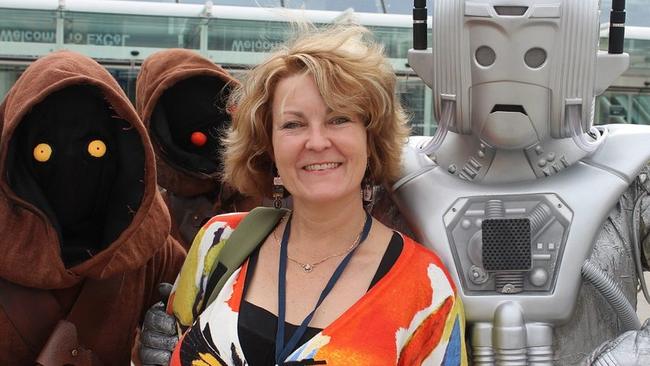Lotus Blue, Cat Sparks; Hugh Mackay, Selling the Dream; Tan, Rubik
Cli-fi, fiction that imagines a dystopian world in the aftermath of climate change, is booming.

Cli-fi, which imagines our world in the aftermath of climate change, is booming. It’s a brand of dystopian narrative that often features desiccated landscapes, where resources are scarce and contested and ingenuity is required just to survive. Lotus Blue (Talos, 382pp, $22.99), the debut novel from Cat Sparks, a much anthologised science fiction writer, is a compelling addition to these ranks.
Star and her sister Nene are travelling the sand road on a truck caravan when they are hit by a sinister, not entirely natural storm. Their caravan is broken up and they are forced to walk to the nearest settlement, where safety is fleeting and where Star becomes aware of the truth of her origins. She is then shanghaied into a mission to fight the Lotus Blue, a sentient war machine that has woken after centuries of sleep with destruction on its mind.
Sparks is extremely adept in her world building and inventive within it. However, given she deploys the conventions of the unlikely quest hero, her protagonist seems underdeveloped. Indeed the characters as a whole are not compelling. There’s a lack of affect and their fates aren’t particularly moving.
Yet this flaw connects with the novel’s great strength: Sparks’s exploration and evocation of artificial intelligence and the hybridisation of humans with machines. Here there are multifaceted considerations, and a good attempt to understand what may motivate intelligent machines once their purpose has been severed from ours. Her conception of how such machines, damaged by the collapse of human civilisation, may function in ways akin to human delusion is fascinating.
Indeed, Lotus Blue is more potent as an imaginary world affected by the delegation of key processes to AI and machines, and the dreams of feral algorithms, than it is of one ruined by climate change. Indeed, it’s hard to know whether such stories have any political efficacy in terms of climate change. Their future is too severed from our present, and the chains of causality insufficient for us to be provoked into action through seeing it as a cautionary tale.
Hugh Mackay is something of a renaissance man: a qualitative market research pioneer but also an observer and author with a sharp sense for his zeitgeist. While his nonfiction books offer popular wisdoms, his fiction has shown a keen eye for adult foibles and the games that motivate us beyond our overt ambitions. In Selling the Dream (Macmillan, 229pp, $29.99) he has written an entertaining satire of the advertising industry, with which he has enjoyed a close relationship for decades.
Lincoln Hunter, in the process of becoming an advertising wunderkind, has changed his name to Lincoln The Hunter and is impressing the three founding partners at his firm, Kelman, Kornfield and Craven, with his capacity to win over the big clients. But Linc is beginning to think he is better than his elders, and his elders get the idea that Linc may not be a team player. Meanwhile there’s a soft drink called The Ripper to be marketed and a budget airline looking for a client.
The novel excels in its creation of a farce where no one is entirely sure what anyone is thinking and everyone is backstabbing everyone else. It’s a smart romp organised around the gradual exposure of flawed Machiavellian behaviour that succeeds mainly because of Mackay’s excellent observational skills. It is knowing Horatian satire, gentler and less outraged than, say, Max Barry’s explorations of the same territory, more reminiscent in its tone of David Lodge’s campus novels such as Nice Work, the workplace as a setting for human folly rather than an expose of systemic evil.
Mackay is mischievously inventive in his construction of the various advertising campaigns that are the glue of the plot. This clever plotting is let down, however, by the gratuitous epilogue, with its evangelical Christian slant, which speaks to a satire of a different sort, and perhaps even a sequel for Linc and some of his colleagues. But for the main part this is witty entertainment of a high order.
Elizabeth Tan’s impressive debut book, Rubik (Brio, 336pp, $29.99), is a series of interconnected short stories that belongs to the art of an Australian generation that has been multicultural since birth, digital natives, constantly connected, and for whom the saturation of commodification with its attendant ethics of marketing and networking is a given.
Tan wrote the book as part of her doctorate in creative writing at Curtin University, where she now teaches. The stories are loosely connected to Elena Rubik, a young woman who goes out for a servo pie one night and gets collected by a Ford Falcon. Many of the connections are tangential, but the linking around a dead woman creates an absence at the centre that is key to the atmosphere of the work.
One of the great advantages of interconnected stories as opposed to novels is that, unbeholden to the demands of narrative arcs, they allow for a prismatic representation of places, moods and ideas. Rubik is set in Perth, but it’s a Perth that feels interchangeable. There is an erasure of specificity at work that aligns with the central absence: the stories take place in fashion retail outlets, supermarket parking lots, primary schools, Officeworks, at night on the road outside a service station. One of the stories is even an email exchange between an automated marketing junk mail and a willingly deluded potential customer looking for someone to talk to.
The presence of William Gibson and his pioneering work in cyberpunk fiction looms large, yet whereas Gibson’s work felt prescient, a vision of something that was yet to arrive, Tan’s writing feels more present, a skew of the contemporary that explores the destabilisation of material reality through the increasing incorporation of our psyches into the processes and networks of the virtual realm.
Tan explores the idea of being alive but nonetheless insubstantial, of having an almost spectral existence, rather than the heavy moral frames of Anglo thought with its traditions of individual substance and agency. It’s an idea, of course, that aligns with the virtual but there are elements here, too, of Haruki Murakami and Banana Yoshimoto or, closer to home, the work of Julie Koh or Tom Cho. There’s an East Asian sensibility to Rubik at the same time as its references make it distinctly Australian.
Ultimately these are stories that explore self-effacement as a response to the hegemony of connection. Occasionally the writing gets a little thicketty, something often encountered with doctorate-driven creative writing with its parallel demands of the exegesis, but on the whole Rubik is deft, strange and playful, kept taut by how it resists letting the absence at its core degrade into lament.


